1948 was a different time in women’s gymnastics. 15 points as the maximum score for optional routines. Flying rings. Ensemble exercises. No all-around competition.
Let’s take a look at the rules.
General Structure | Routine Composition | Judging | Scoring | Miscellaneous Rules | Apparatus Norms | Documents | Flying Rings | Tremplin élastique vs. tremplin dur
General Structure of the Competition
10 gymnasts per team, 8 gymnasts maximum per event, 6 best all-around scores
Each nation can register a team of 10 gymnasts of which 8 at most and no less than 6 will take part in all the exercises. The result of the competition will be decided by taking all the points obtained by the six best gymnasts from each national team.
All translations are my own. For doubts, consult the original French documentation.
Note: The team totals weren’t on the 6 best scores on each event. Rather, they were based on the six best all-around scores.
Team competition only
The women’s gymnastics competition is for teams only: no individual prize will be awarded, neither for the all-around nor for the individual events.
Though, most reports still calculated individual winners.
What the women’s artistic gymnasts competed on
Ensemble exercise on floor
Ensemble exercise on floor with portable apparatuses (similar to rhythmic gymnastics today)
Compulsory routines on:
- Flying rings
- Balance beam
- Vault on pommel horse (it actually had handles)
Optional routines on:
- Balance beam
- Vault on pommel horse (it actually had handles)
Films of compulsory routines were available.
To avoid the possibility of interpreting differently the description of the compulsory exercises, the F.I.G. will procure with the help of the Women’s Technical Committee a film with the compulsory routines for the benefit of the participating organizations.
No changes to line-ups after submission
Before 6 o’clock in the evening the day before the start of the competition, the coach of each team will nominate from the list of 10 gymnasts already registered, the 6 to 8 gymnasts who will perform on each apparatus in the order in which they will compete. From this moment no changes will be allowed in team personnel or in the order of the lineup.
Routine Composition
Ensemble routines with portable apparatuses
Exercises with portable devices should include the whole body. We must also consider the beauty of the formations which, of course, should not be detrimental to the physiological value of the composition.
Between 4 and 5 minutes.
Skills such as bridges and splits are undesirable and decrease the score for the physiological value and add nothing to the difficulty of the composition.
Note: The ensemble exercises were much shorter than they had been previously. At the 1928 Olympics, the ensemble exercises were supposed to last between 13 and 15 minutes.
Music for ensemble routines
The two group exercises will be accompanied by music. The rhythm and character of the music must match the movements.
Optional Routines
The optional apparatus exercises must contain four to five elements of the highest difficulty. All strength and power exercises are considered undesirable. The optional exercise on beam must differ at least in part from the compulsory exercise.
Many gymnasts from the same team can perform the same vaults. It is left to the choice of the competitors whether or not to touch the pommels.
Optional and compulsory routines must differ.
For the optional routines, we will not score the elements of the compulsory routines that are presented with the same sequence and in the same way.
Note: In 1948, the vault was a pommel horse. At the 1950 World Championships, that changed, and the women’s artistic gymnasts competed on a pommel-less horse.

General Instructions for the 1950 World Championships
Judging
Requirements for Judges
Each federation announces 2 to 4 people who will serve as judges. Their competence and fairness must be above all suspicion, and in the competitions of their Federations, they have perfected themselves in judging matters. The names and qualifications of the judges and their addresses must reach the President of the Women’s Technical Committee, Madame Provazníková, at the latest one month before the competition.
A Commitment to Avoid Bias
Each member of the Jury must solemnly commit to evaluate only the execution of the exercises without regard to the person or the nationality of the gymnasts.
Judges’ Course
In order to arrive at a scale of evaluation as uniform as possible, a scale of deductions has been established and we will organize a mandatory two-day training session in London for all judges involved. Judges who could not participate in this examination will not be allowed to judge.
How Routines Are Judged
The rating of each artistic performance is done by evaluation. For the whole competition, there will be working judges and substitute judges. Each exercise will be judged and assessed by 4 judges of different nationalities. Each juror will judge the exercises separately, without consulting the others.
Note: Starting with the 1950 World Championships, women’s artistic gymnasts would have five judges:
On the individual events, the Jury will be made up of 5 judges.
Aux épreuves individuelles jugées par taxation, le Jury se composera de 5 juges.
General Instructions for the 1950 World Championships
The 1968 Code of Points reinstated a four-judge system for women’s artistic gymnastics.
Compulsories = execution
Optionals = execution, difficulty, and combination
In terms of scoring the compulsory exercises — the apparatuses and vaults — execution alone is subject to judgment, the routines being the same for all the competitors, the difficulty and the combination are not to be judged. The routines are judged by accuracy, elegance, and sureness of execution. To these factors are added for the optional exercises the difficulty and the combination.
All Scores Shown at Once
At the signal of the group leader, all judges will show their scores to the public. We make available to each of them a series of signs with sufficiently large numbers. Judges’ notes will be written on score sheets.
Average of the two middle numbers
The Calculators Commission will strike out the two extremes and this is the average of the others which will be the final mark.
Note: On the men’s side, it was the sum of the two middle numbers — not the average — in 1948.
Ensemble routines were judged differently
The group exercises will be judged by 3 groups of judges, each of these groups composed of 4 judges of different nationalities.
The first group will judge the difficulty and the physiological value of the exercise.
The second, beauty and composition.
The third, the precision of execution and the coordination of the group.
Scoring Breakdowns
Compulsory routines (10-point maximum)
An exercise executed perfectly and in its entirety is scored out of 10 points maximum:
7 points for the perfect execution of all the parts and all the combinations
3 points for the general impression
To facilitate and unite points of view on scoring, we established a list of faults with their relative importance and the deductions will be established by an analysis of the compulsory exercises which will contain the evaluation of each element and each combination, as well as a scale of penalization of these faults.
Optional exercises on the apparatuses (15-point maximum)
Perfect execution is awarded 10 points, plus a maximum of 5 points for difficulty and combination — 4 for difficulty, and 1 for the combination. A gymnast performing a routine without faults, of the highest difficulty and of a beautiful and continuous combination — she can earn 15 maximum points.
Optional vaults (15-point maximum)
Perfect execution is valued at 10 points where:
1 point for the approach and take off
7 points for the vault
2 points for the landing
The evaluation of the difficulty can reach 5 points maximum.
Again, 15 was the maximum.
Ensemble exercises with portable apparatuses (70-point maximum)
The difficulty of the exercise and its physiological value: 15 points
The beauty and the combination: 15 points
The precision of the execution and the coordination of the ensemble: 40 points
70 points maximum
Maximum Team Total (500 points)
3 compulsory routines on apparatuses: 3 x 10 points x 6 competitors = 180 points
2 free exercises on apparatuses: 2 x 15 points x 6 gymnasts = 180 points
2 ensemble exercises: 140 points
Total: 500 points
Miscellaneous Rules
No Routine Repetitions
Corrections are not permitted except for the case where normal execution has been prevented by a case force majeure. The exception is made for vault where it is allowed to make a trial jump which is not scored before doing the two jumps of the competition. The last two will be scored and rated according to the values set. It’s the best that will count for ranking.
Note: This is different from the men’s competition. The men could repeat their compulsory routines.
Once you’re out, you’re out
Any gymnast leaving their section without authorization of the Jury will not be able to re-enter.
But if you’re injured, you get 30 minutes.
It is not allowed to substitute one gymnast for another during the competition. It is only in the ensemble exercises that an injured gymnast during the competition can be replaced by one of the substitutes named in the nominative list. The injury must be noted and checked by the doctor on duty.
Any indisposition, any accident must be immediately reported by the directors and noted by the doctor on duty. In order to allow the unwell gymnast to recover, the section may interrupt work for 30 minutes maximum. If, after this period, the observed incapacity persists, the section will resume its work, and the gymnast in question is eliminated.
On attire
Competition clothing must be uniform for all gymnasts from the same section. They must wear a common badge. The outfit cannot be changed nor modified during the contest.
Gymnasts can work in shoes or barefoot.
For the ensemble exercises, they can change their outfit.
Apparatus Norms
Flying Rings
| Dimension | Specification |
| Height of Portico | 550 cm |
| Height of Rings | At the height of the gymnast’s raised hands |
| Inner Diameter of Rings | 18 cm |
| Diameter of Rings | 28 mm |
Additional Notes:
The ropes may end with straps or movable straps to which the rings attach.
Polished wooden rings.
My thought bubble: Adjusting the height of rings is a pain, and it takes time. Imagine trying to adjust the height of the rings for every gymnast. A logistics nightmare.
By the way, you can see the Czechoslovak gymnasts training on the flying rings in 1947.
Side Horse Vault
| Dimension | Specification |
| Height of the Horse from the Top of Board | 110 cm |
| Distance of Horse from Board | Open |
| Tremplin élastique (Elastic Board) | Approx. 40 cm high |
| Length of Board | 190 cm |
Note: Today’s vault dimensions aren’t easily comparable.
Today, the highest portion of the vault table is 125 cm, and the springboard is about 22 cm high. So, the distance from the board to the table is about 103 cm. (Today’s board is only 120 cm long.)
In 1948, the board was 40 cm high, and the height of the horse was 110 cm from the top of the board. So, the height of the horse was 150cm from the floor, giving gymnasts ample time to land.
Not sure what a “tremplin élastique” (elastic board) is? Don’t worry. I didn’t either, so I did the research for you. More on the tremplin élastique and evolution of vaulting boards below.
Balance Beam
| Dimension | 1948 | 2021 |
| Width | 10 cm | 10 cm |
| Height | 120 cm | 125 cm |
| Length | Approximately 5 m | 500 cm |
Today, the beam is about 2 inches higher (5 cm specifically) than it was in 1948, and today, the length of the beam is a firm 500 cm rather than “approximately” 5 m.
Countries could bring their own apparatuses
The competing teams are free to bring their apparatuses and install them at their own expense and risk in the place designated by the Organizing Committee. The essential dimensions of these devices must comply with the provisions of this text and will be checked by the bureau of the jury. They will be at the disposition of the gymnasts who will ask work on these gears.
Note: Starting with the World Championships in 1950, countries could no longer bring their own apparatus to the competition:
All apparatus must be made available by the Organizing Committee. The latter is required to comply with regulatory provisions as well as with the instructions given by the Executive Committee.
A double set of apparatus will be used for team training a few days before the competition. No nation will be allowed to use its own equipment in the competition.
Tous les engins doivent être mis à disposition par le Comité d’organisation. Ce dernier est tenu de se conformer aux dispositions réglementaires ainsi q’aux instructions que la Commission exécutive lui donnera.
Un jeu double d’engins servira à l’entraînement des équipes quelques jours avant le concours. Aucune nation ne sera autorisée à utiliser ses propres engins au concours.
General Instructions for the 1950 World Championships
Documents
Appendix A: Women’s Flying Rings
To modern gymnastics fans, flying rings for women seem odd.
But flying rings were part of certain national and ethnic traditions. For instance, as you can see, women’s flying rings were part of the German-American system in 1896.
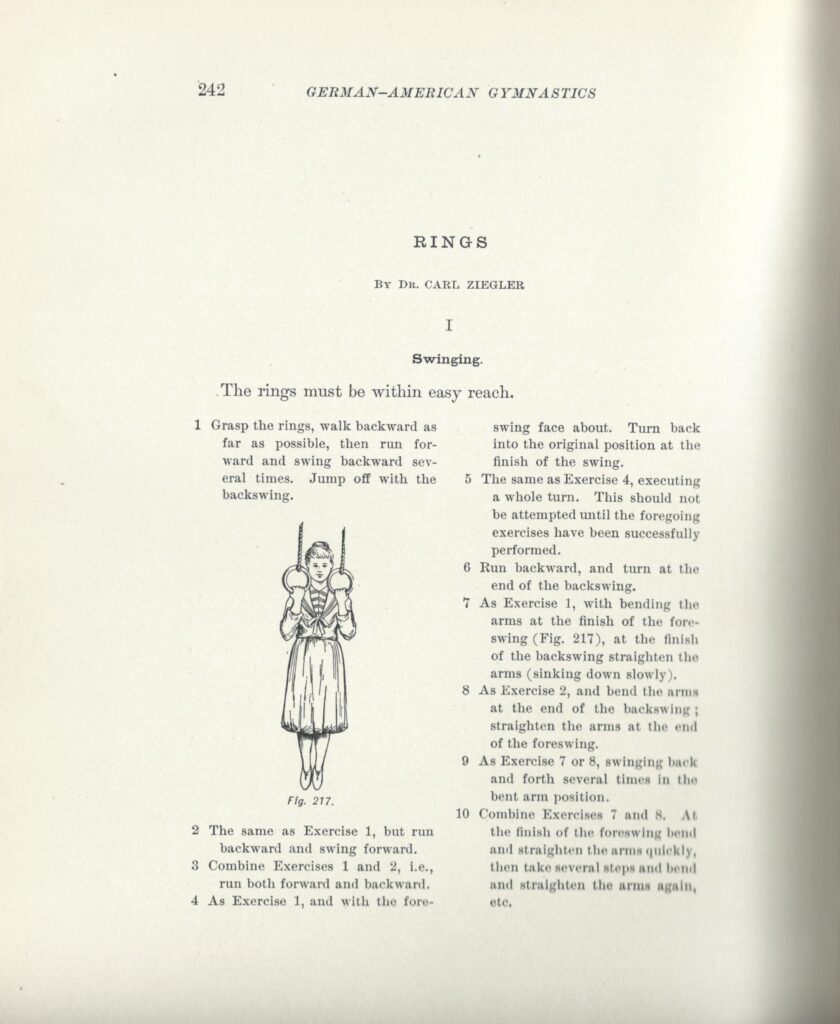
Gymnastics: A Text-Book of the German-American System of Gymnastics, Edited by W.A. Stecher, 1896
The Early History of the Rings
The rings were a popular circus apparatus, and the German gymnast and educator Adolf Spieß is often credited with developing them into a gymnastics apparatus. His work was influential in both the German and Swiss systems of gymnastics.
Spieß writes about rings in his book Die Lehre der Turnkunst (System of Gymnastics), specifically the volume titled Das Turnen in den Hangübungen für beide Geschlechter (Hanging Exercises for Both Sexes), published in 1842 in Basel, Switzerland.
As the title of the volume suggests, Spieß saw rings as an apparatus for both sexes.
Spieß’s rings were somewhat different from the rings of today. For starters, they were made of iron and wrapped in leather:
Two iron, leather-covered, finger-thick rings, half a foot in diameter, which are provided on one side with small movable iron rings for turning, hang on the small rings, attached to two small-finger-thick ropes.
Zwei eiserne, mit Leder überzogene, fingerdicke Ringe, von einem halben Fuß Durchmesser, welche an einer Seite mit kleinen beweglichen eisernen Ringen zum Drehen versehen sind , hängen , an den kleinen Ringen , an zwei klein fingerdicken Seilen befestigt.
Das Turnen in den Hangübungen für beide Geschlechter
In his book, Spieß described various ways to swing on the apparatus, including starting from a stand (auf dem Stand) and walking (aus dem Gehen) or running (laufen) into the swing:

Spieß even included using one’s upper arms as a way to swing:
Hangschwingen in Oberarmhängen
If you look at old gymnastics books, you’ll sometimes see gymnasts with their arms through the rings. For example, Figure 225 below:
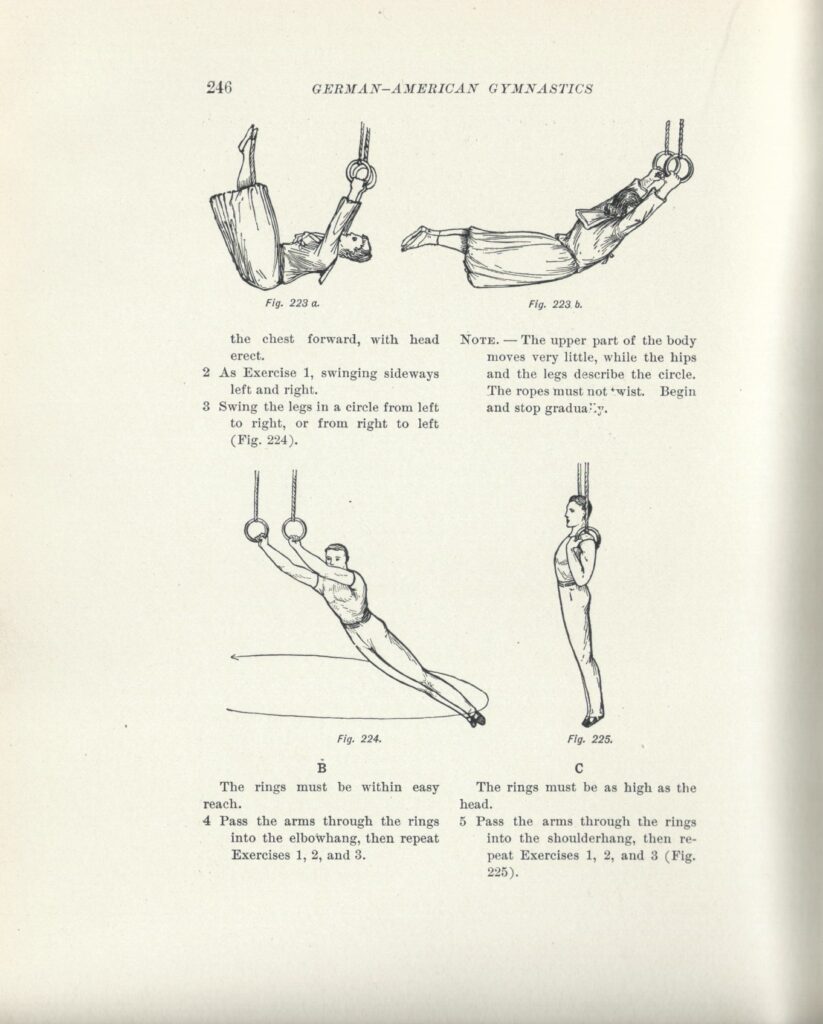
Side note: Can you imagine doing gymnastics in a dress?
When Jahn, the Turnvater (Father of Gymnastics), published the second edition of his Deutsche Turnkunst (German Gymnastics) in 1847, he took a page from Spieß and included rings as an apparatus.

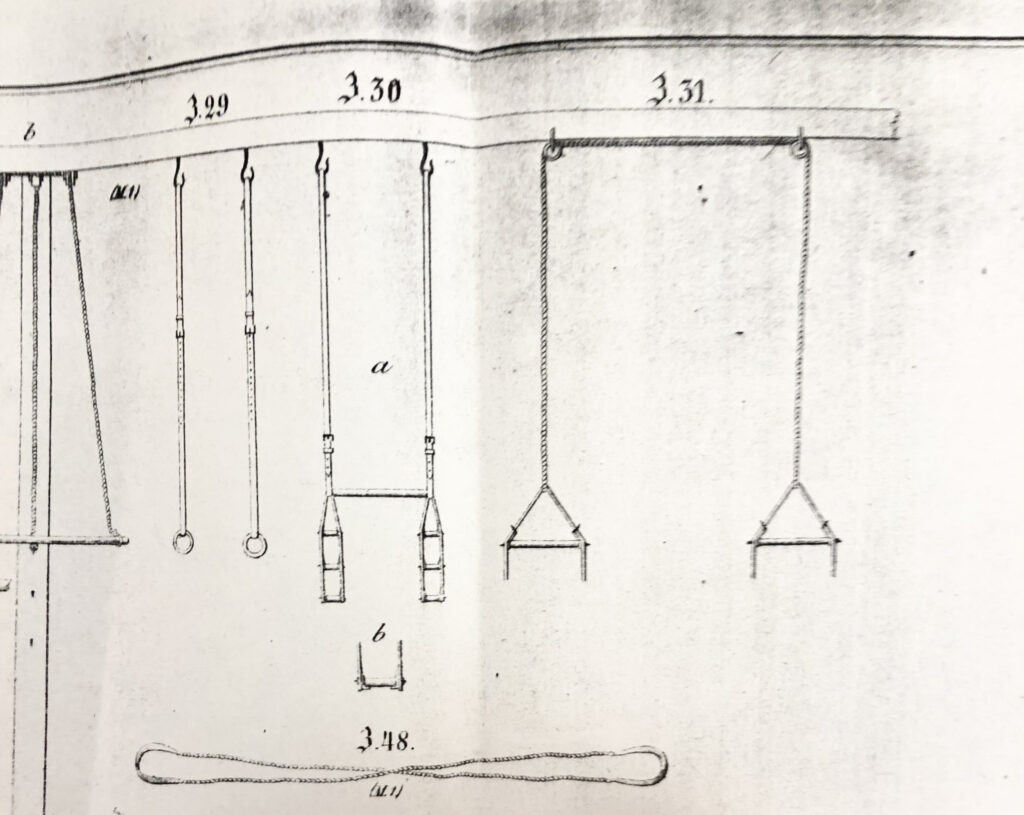
Note #2: At the 1908 Olympics, male gymnasts performed optional routines on both the flying rings and still rings. At the 1926 World Championships (called the “International Tournament” at the time), the Dutch gymnasts performed their optional rings routines in the form of flying rings. This was the last time flying rings appeared in an international men’s competition.
Women and the Flying Rings in the FIG
The German-American system had women doing both flying rings and still rings.
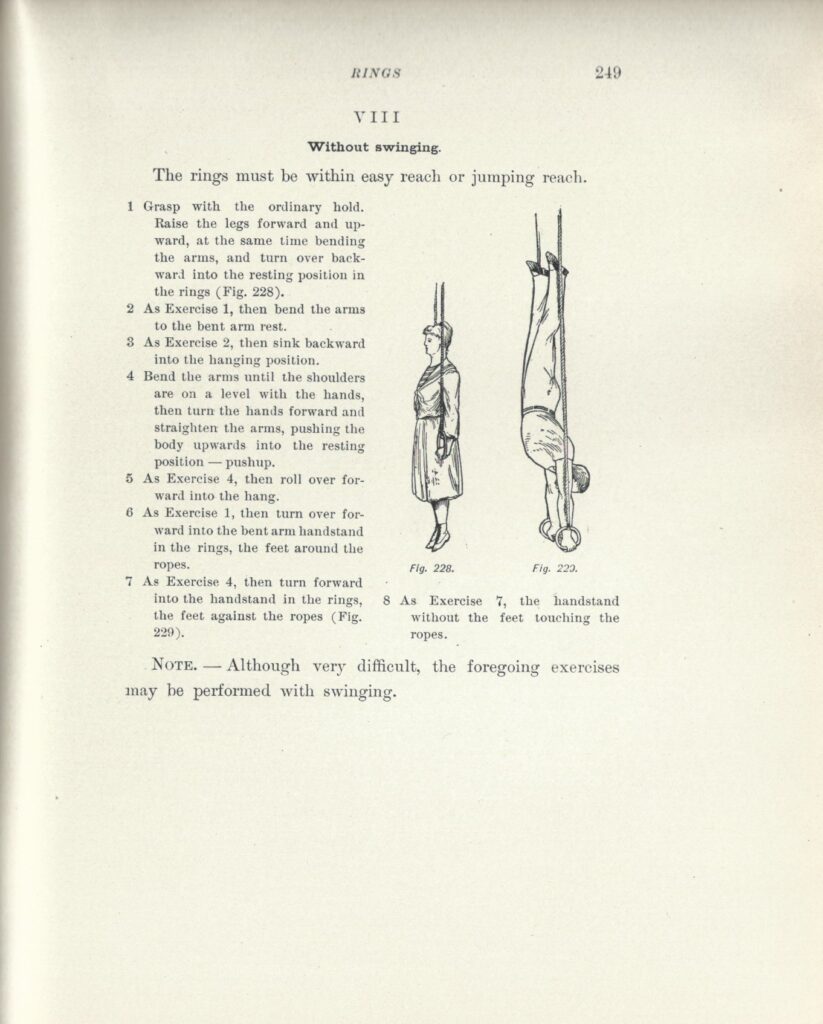
Gymnastics: A Text-Book of the German-American System of Gymnastics, Edited by W.A. Stecher, 1896
However, women’s artistic gymnasts would never compete on still rings at FIG events. And the flying rings had a short existence at FIG competitions for female gymnasts.
The swinging rings weren’t part of the 1928 or 1936 Olympic Games, nor were they part of the 1934 World Championships.
They made their first appearance at the 1938 World Championships and returned after World War II as part of the 1948 Olympic program. Both times, the flying rings were compulsory-only routines.
At the 1950 World Championships, the FIG opted for a unique approach. Women’s artistic gymnasts had the choice of uneven bars (barres parallèles à hateurs différents) or flying rings (anneaux balançants) for both compulsory and optional routines.
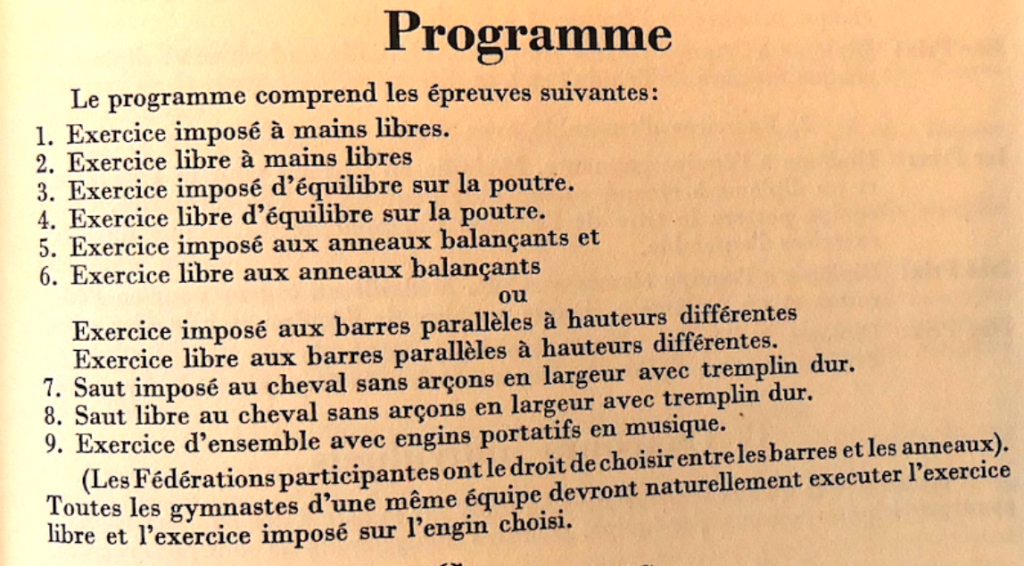
Beyond the FIG: Flying Rings after 1950
The flying rings disappeared from the FIG’s program after the 1950 World Championships. (The 1950 FIG Congress voted to eliminate the apparatus.)
Nevertheless, they didn’t disappear entirely from gymnastics. You can see the Soviet women competing on the flying rings in 1952 in this video:
And you can see that the Soviet men continued to train on the flying rings, as evidenced by this visual training aid from 1953:
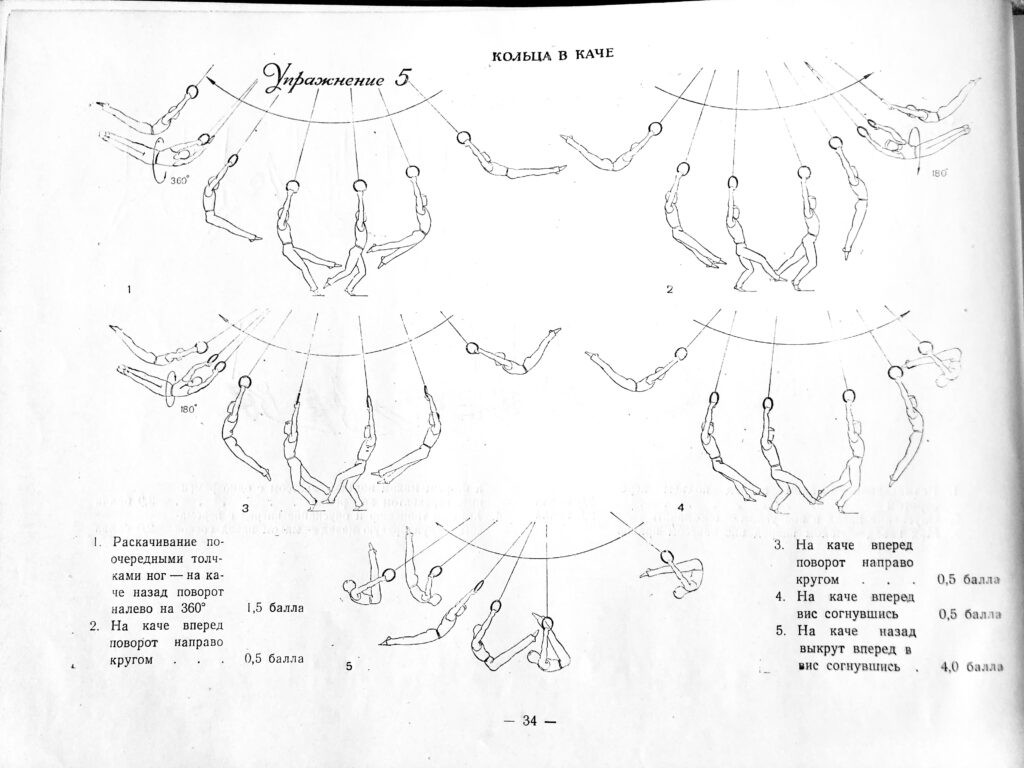
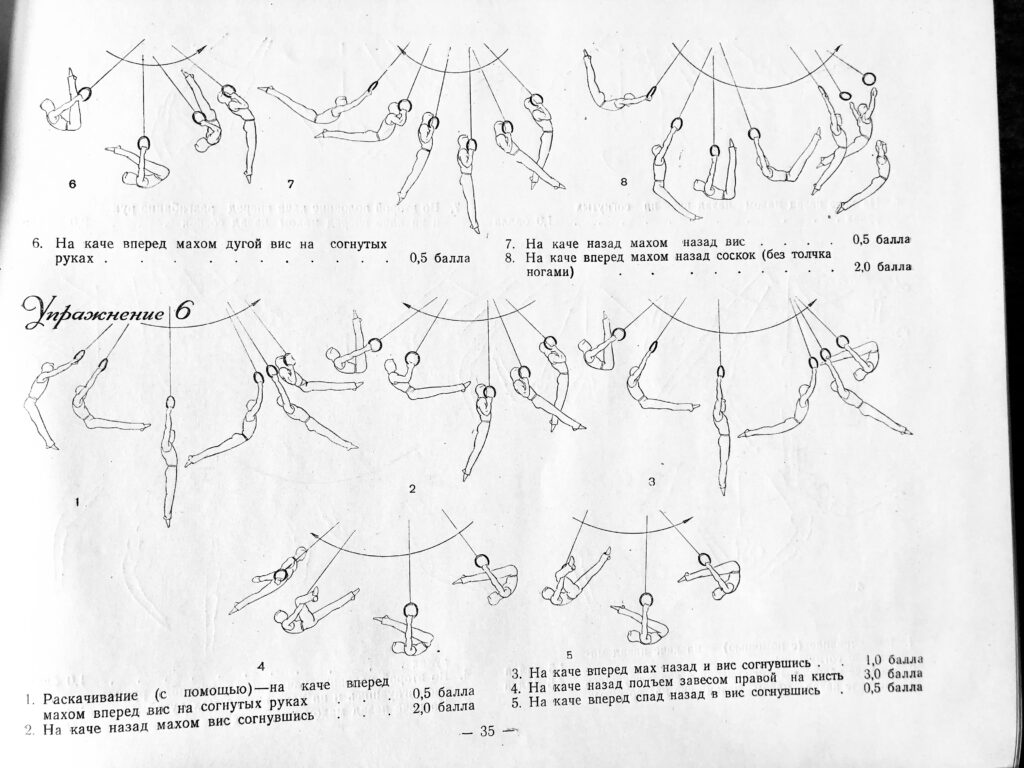
And the men competed on the flying rings at various Swiss competitions over the years, including the 1967 Turnfest in Bern.
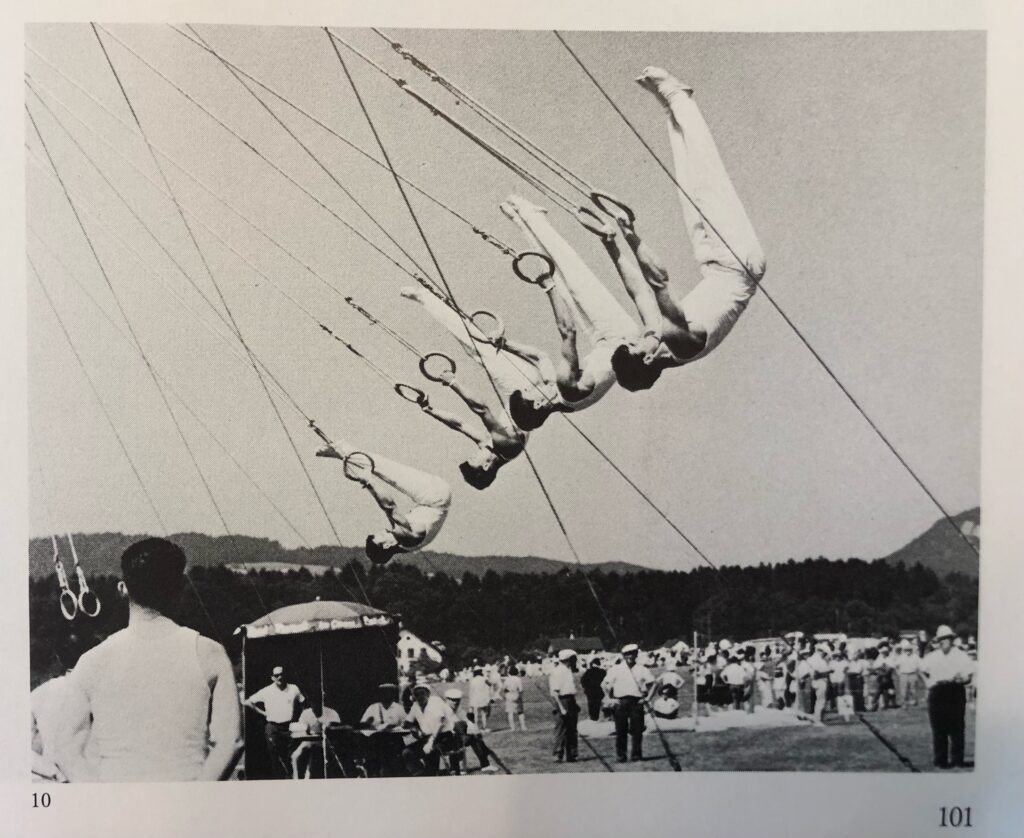
As did the Swiss women, as seen here at the Concours de section circa 1978.
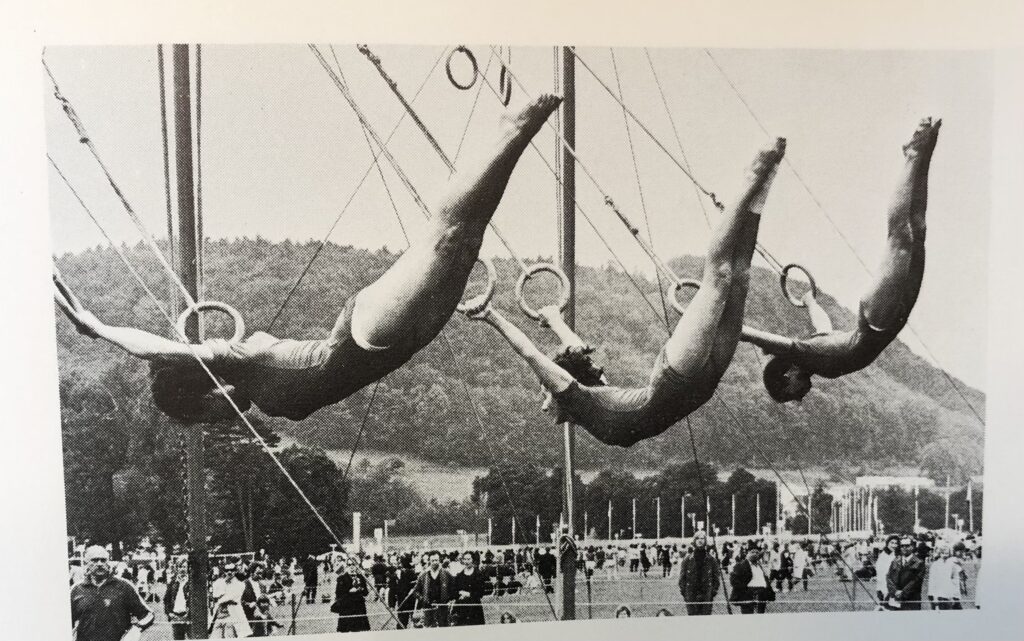
In the United States, the apparatus was a staple at Muscle Beach in Santa Monica, California for decades.
And the flying rings continued to live on at gymnastics shows like Gymnaestrada.
As well as Cirque du Soleil.
Appendix B: The tremplin élastique vs. the tremplin dur
Whereas the men used a “tremplin dur” (hard board), the women used a “tremplin élastique” (elastic board) in 1948. I was curious about the difference, so I looked into it.
Note: I will use the French terms throughout this section simply because we don’t have the vocabulary to describe the various types of boards in modern English.
On the Difference in Construction
Tremplin élastique
The “tremplin élastique” offered:
an improvement in the level of elasticity thanks to a longer board reinforced from below and resting on a crosspiece made of soft wood.
une amélioration au niveau de l’élasticité grâce à une planche plus longue renforcée par en-dessous et reposant sur une traverse en bois souple.
Les étapes de la gymnastique au sol et aux agrès en France et dans le monde
The crossbar made of softwood would bend and, upon returning to its normal shape, fling the gymnasts into the air.
You can see an early sketch of a “tremplin élastique” from Jahn’s second edition of Die Deutsch Turnkunst in 1847:
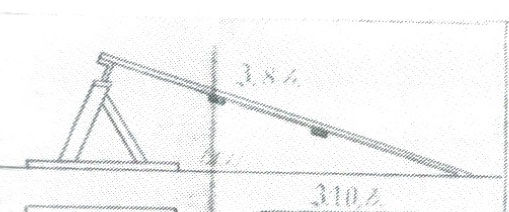
And another illustration at the bottom of this page from the book Pour être bon gymnaste (To Be a Good Gymnast, circa 1930):
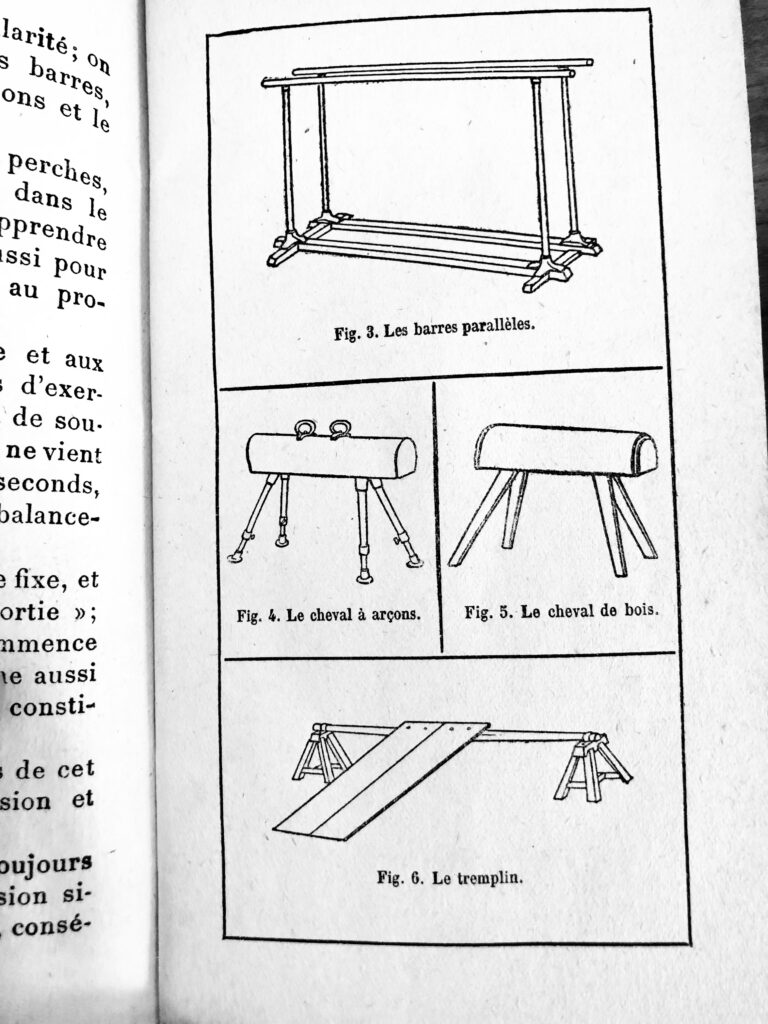
And here’s an elastic board in action:
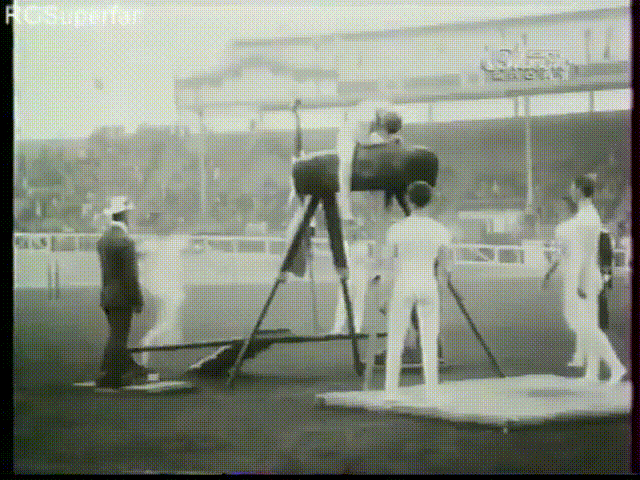
Can you ever have too many visuals of elastique boards?
By 1928, the design of the “tremplin élastique” had bifurcated in two separate directions.
In the 1928 rulebook for the Olympics, the athletes had two different options for elastic boards. The first option was the “tremplin à poutre,” which was the traditional “tremplin élastique” with the long supple crosspiece, as we discussed above.
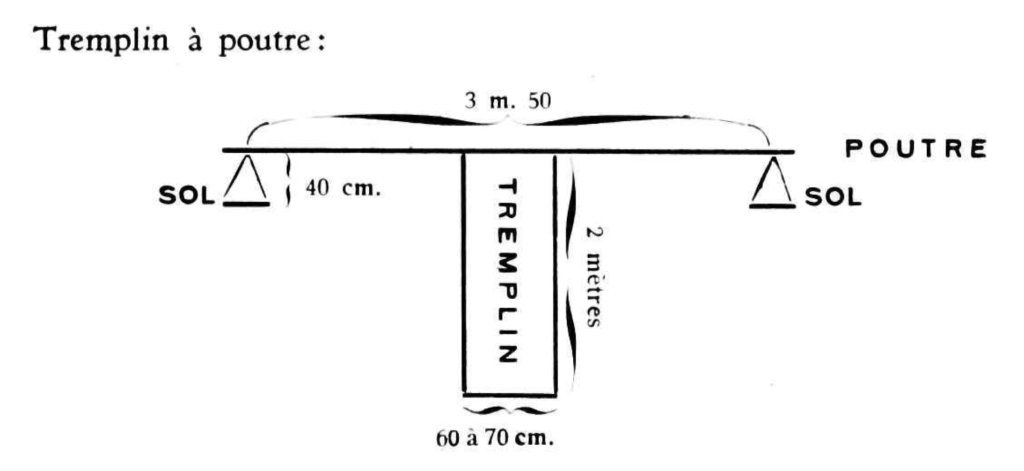
Alternatively, gymnasts could use a “tremplin à ressorts” (springboard) in 1928. Here is the springboard diagram used in the rulebook for the 1928 Olympics.
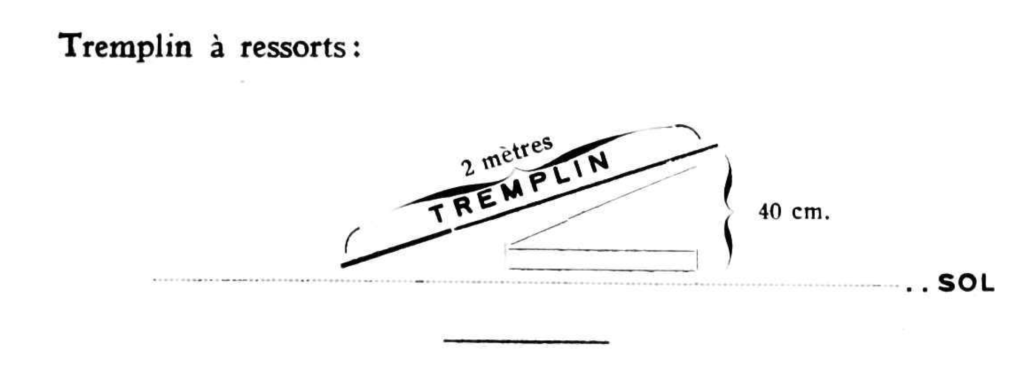
The “tremplin à ressorts” no longer used a long, supple crossbeam to provide its elasticity. However, it had not evolved into the springboard of today with coiled spring.
You can see an example of the modernized “trempin élastique,” or “tremplin à ressorts,” in this photo from the 1947 Swiss Gymnastics Festival in Bern:
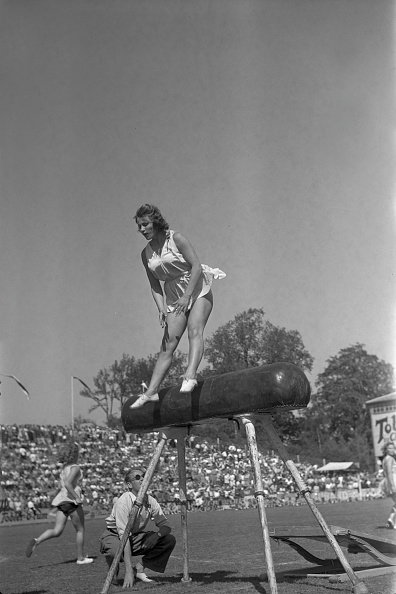
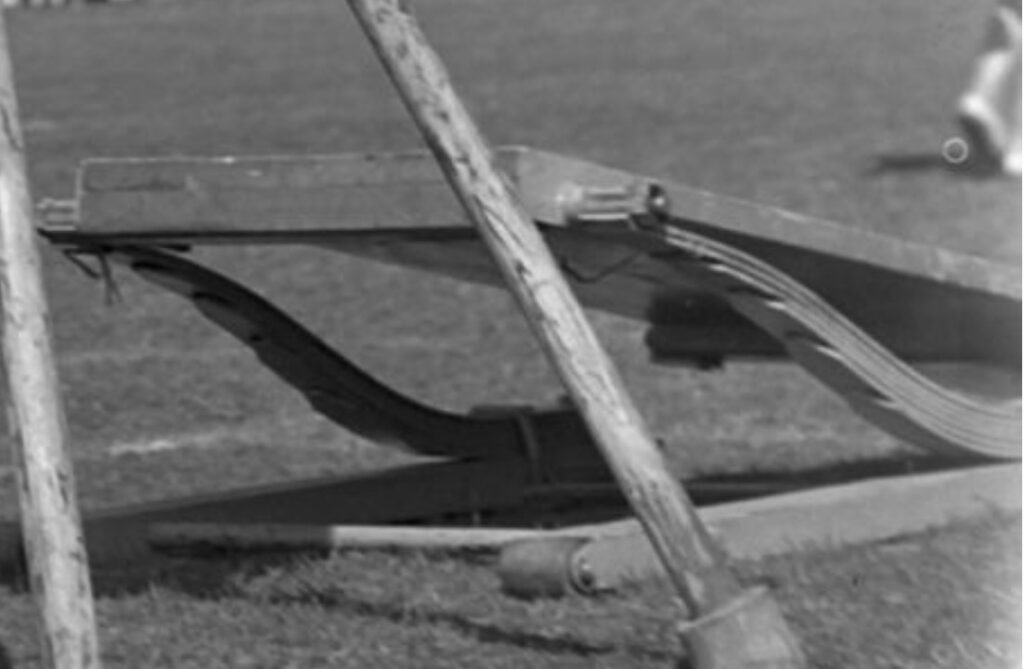
The early springboard (“tremplin à ressorts”) was the type of board used at the 1948 Olympics for the women’s competition. You can see an example in this image of Empress Hall, where the gymnasts competed during the London Olympics:
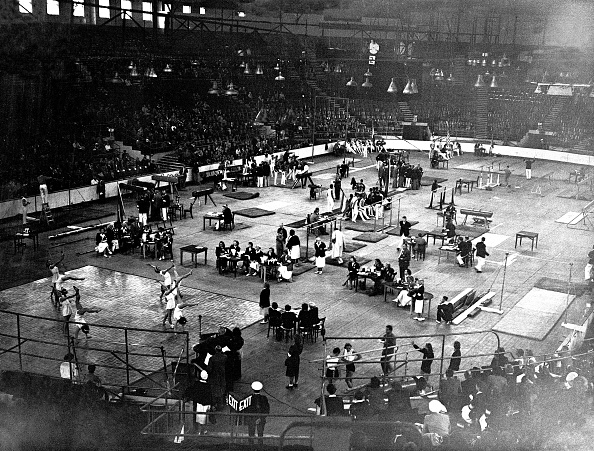
Don’t see it? It’s like a game of “I Spy.” Here’s a close-up of it:
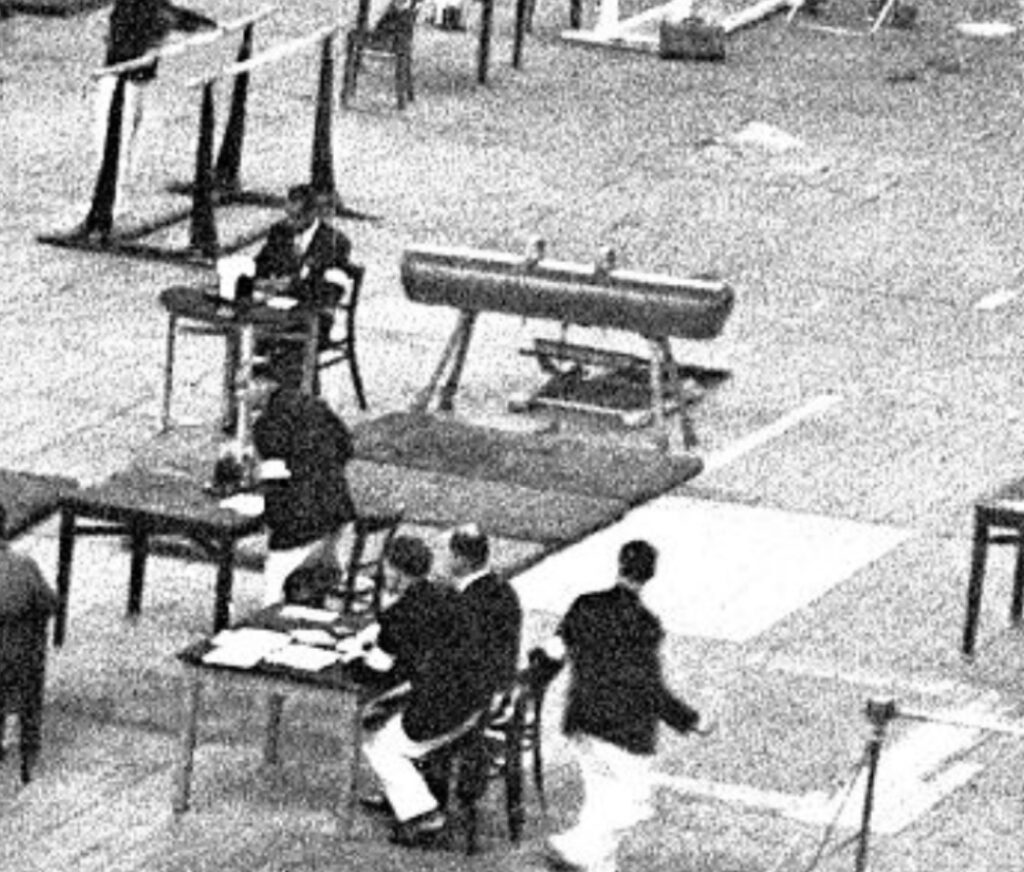
The design of the “tremplin à ressorts” (springboard) would continue to evolve. Here’s an example of an early springboard from 1964:
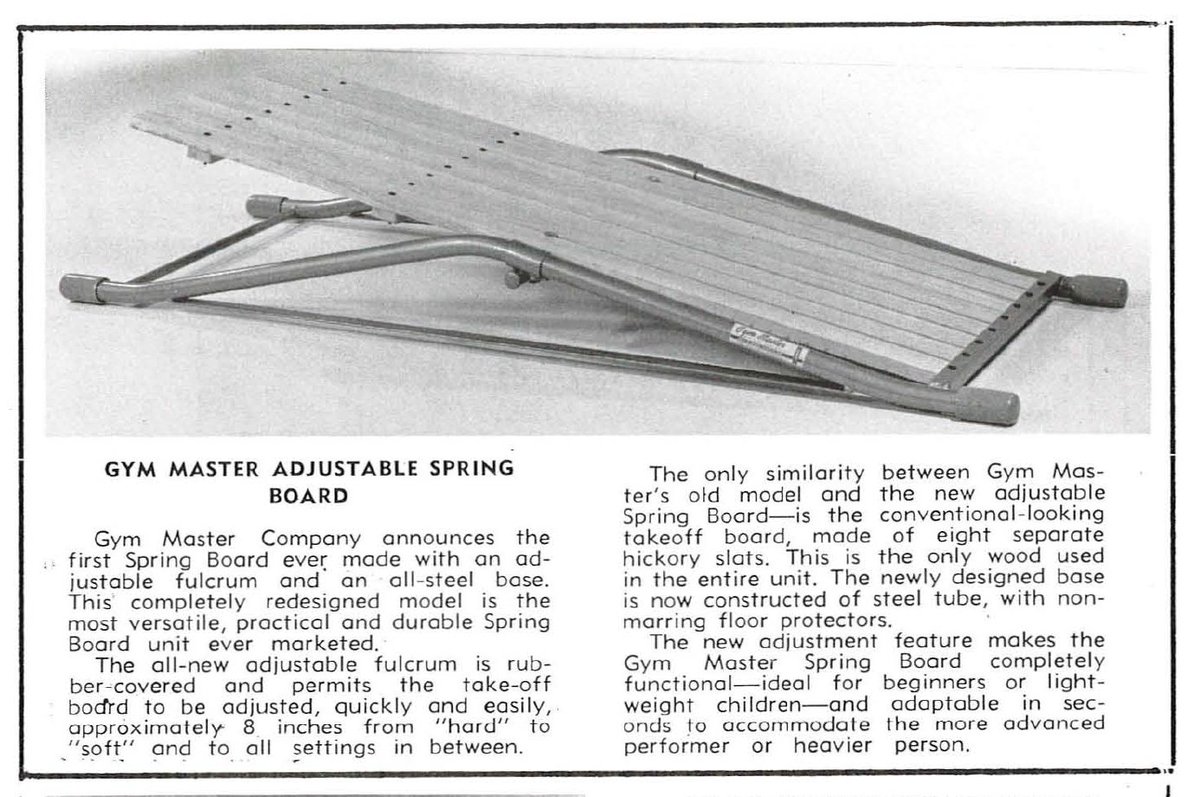
Tremplin dur
Meanwhile, the “tremplin dur” was:
a very low board that is barely ten centimeters high, consisting of a shorter board and resting on a large wooden cleat. Originally, as [Nicholas] Cupérus points out, this hard board “is a board intended to mark the place where it is necessary to put the foot,” but its aim is also “to provide the resistance that the ground would not always offer for strong and often repeated foot strikes.”
un tremplin très bas qui fait à peine une dizaine de centimètres de hauteur, constitué par une planche plus courte et reposant sur un gros tasseau de bois. A l’origine, comme le souligne Cupérus, ce tremplin dur — par opposition au tremplin élastique — “est une planchette destinée à marquer l’endroit où il faut poser le pied”, mais son but est aussi “de fournir la résistance que le sol n’offrirait pas toujours à des appels du pied d’une grande force et souvent réitérés.”
Les étapes de la gymnastique au sol et aux agrès en France et dans le monde
Nicholas Cupérus was the first president of the Fédération Européenne de Gymnastique, which consisted of Belgium, France, and the Netherlands. In 1921, that federation changed its name to the Fédération Internationale de Gymnastique.
Remember: They used to compete outdoors, so if competitors repeatedly jumped in the same spot, the ground would sink in, making it harder to vault. Hence the reference to “repeated foot strikes”
Here’s a drawing of a “tremplin dur” from Jahn’s second edition of Die Deutsch Turnkunst:

It was basically a wooden ramp with small wooden pieces underneath at the highest part (10 cm off the ground) of the ramp. While it provided some spring, it was not nearly as springy as the “tremplin élastique.”
You can see an example of a “tremplin dur” in this photo from the 1936 Olympics:
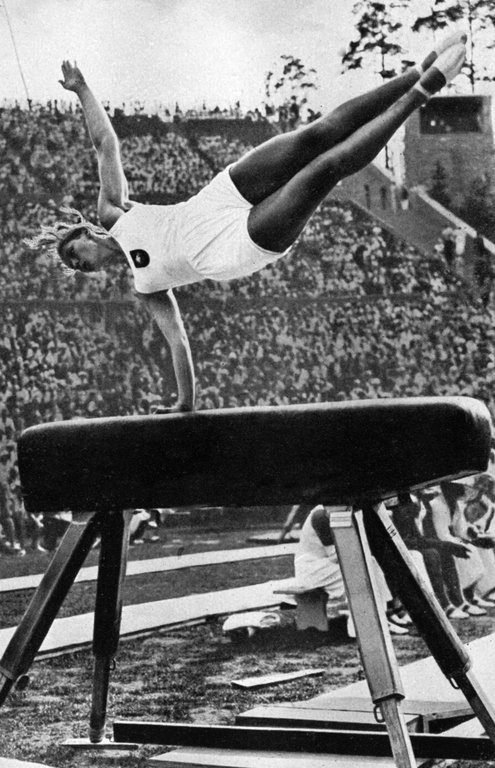
The tremplin is the little ramp in front of the horse.
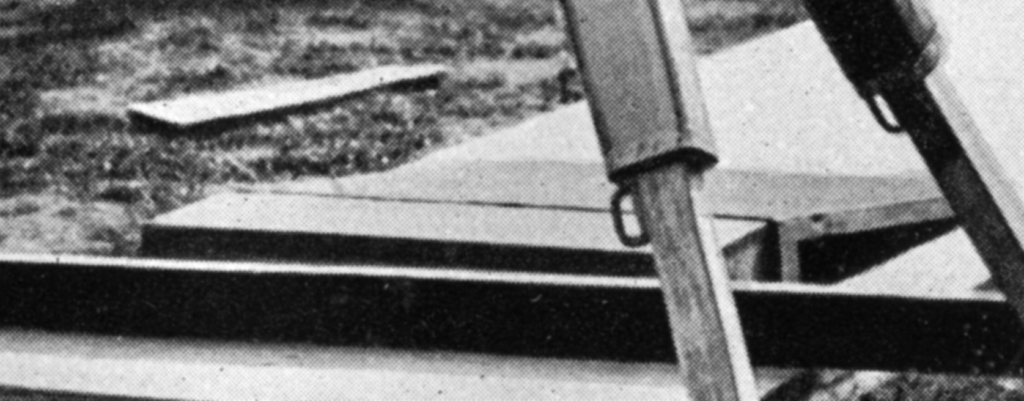
1956: The Reuther Board
In 1956, boards would change:
From 1956, an intermediary between these two boards was found with the invention of the semi-elastic board by Richard Reuther.
A partir de 1956, un intermédiaire entre ces deux tremplins est trouvé avec l’invention du tremplin semi-élastique par Richard Reuther.
Les étapes de la gymnastique au sol et aux agrès en France et dans le monde
Below is an example of a Reuther board from 1973.
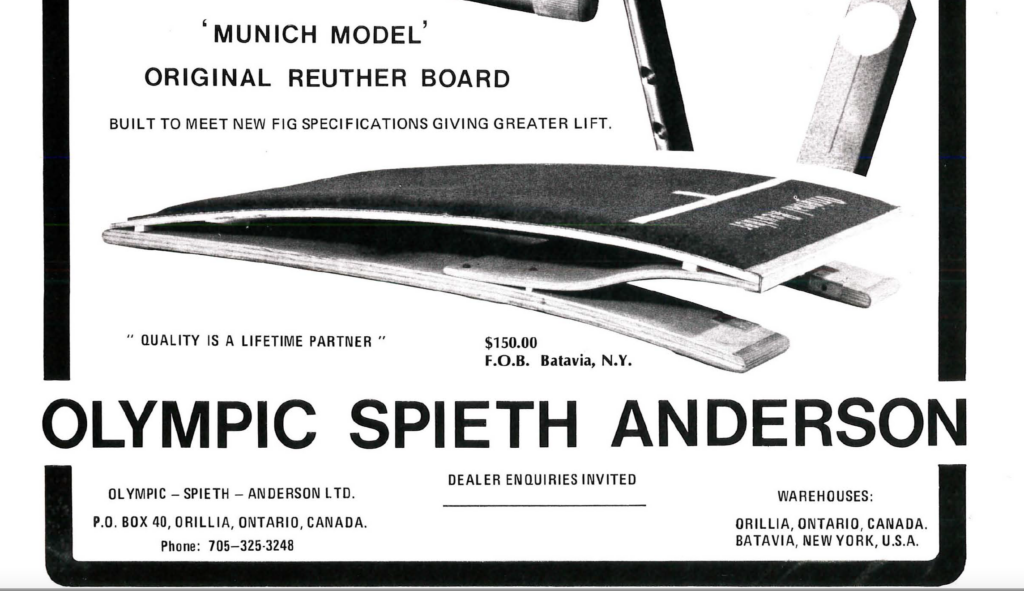
Notice how the supports use the same S-shape curve of the “tremplin à ressorts” from the 1940s above. However, the height of the board is much lower — like that of a “tremplin dur.”
The 1964 women’s Code of Points officially allowed for the use of Reuther boards in competition.
On the Difference in Perception
The “tremplin dur” and the “tremplin élastique” weren’t just different in construction. In the 1950s, they had different cultural connotations attached to them, as well.
The following comes from Les Jeunes, which was the publication of the Fédération Gymnastique et Sportive, which was one of the gymnastics federations in France.
Vaults practiced by our gymnastics teams are executed with the aid of an elastic board. Within the other French federations and foreign federations, vaults are performed with the aid of a hard board.
The take-off on a hard board needs more power and it has a tendency to give female gymnasts too much muscular development. This is the reason why our Federation opted for the elastic board – the elasticity of the board helps with the effort of propulsion, it is less intense and less brutal and is more suitable for female gymnasts.
The height of the horse is also to be considered. Much higher for the elastic board vault, it leads to greater daring, a quality that is useful to develop in young girls.
The adoption of a semi-flexible board by other Federations tends, apart from the question of virility/power, to come closer to our conception.
Le saut au cheval pratiqué par nos sections de gymnastique s’exécute à l’aide d’un tremplin élastique. Dans les autres Fédérations françaises et étrangers, les sauts s’effectuent à l’aide d’un tremplin dur.
L’appel sur tremplin dur nécessite une puissance de détente supérieure et a tendance à donner aux gymnastes féminines un développement musculaire trop important. C’est la raison pour laquelle notre Fédération avait opté pour le tremplin élastique — la elasticité du tremplin apportant aide à l’effort de détente, celui-ci est moins intense et moins brutal et convient mieux aux gymnastes féminines.
La hauteur du cheval est également à considérer. Beaucoup plus élevée pour le saut au tremplin élastique, elle conduit à une plus grande audace, qualité qu’il n’est pas inutile de développer chez les jeunes filles.
L’adoption d’un tremplin demi-souple par les autres Fédérations tend, mise à part la question de virilité, à se rapprocher de notre conception.
Les Jeunes, Oct 1, 1955
In other words, using a “tremplin élastique” was, by the logic of the Féderation Gymnastique et Sportive in the 1950s, a way to maintain certain feminine ideals about the female body — ones that didn’t want to present the female body as being excessively muscular or strong.
However, as the quotation from Les Jeunes notes, there were federations that didn’t share this view and chose to use a “tremplin dur” for the women’s apparatus.
That included the FIG.
At the 1950 World Championships, the FIG abandoned the “tremplin élastique” for the women and instead used a “tremplin dur” — just like the men.

General Instructions for the 1950 World Championships
One More Piece of Gym Nerd Trivia
At the 1932 Olympics in Los Angeles, the men competed using both a “tremplin dur” and a “tremplin à ressorts.” In fact, they performed four vaults:
- 2 compulsory vaults with the vault at 1.30 m and a tremplin dur of 10 cm
- 1 optional vault with the vault at 1.30 m and a tremplin dur of 10 cm
- 1 optional vault with the vault at 1.80 m and a tremplin à ressorts (springboard)
In other words, three vaults with this type of board:

And one vault with this type of board:
